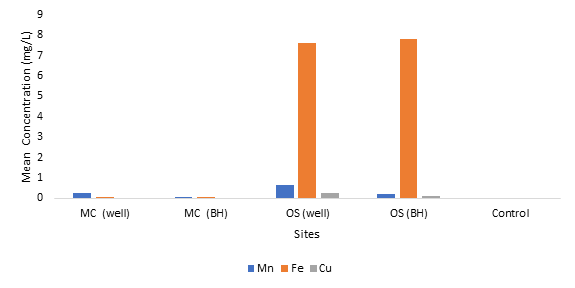Assessment of Drinking Water Samples Around Selected Oil Spillage and Metal Recycling Company in Lagos State, Nigeria
Heavy-metals in drinking waters
Keywords:
Heavy metals, Environmental pollution, Flame atomic absorption spectrometry, Oil spillage, Metal industryAbstract
In recent times, anthropogenic source has been considered to be one of the major sources of environmental pollution. In this study, the levels of six heavy metals (Cadmium -Cd, Copper-Cu, Chromium-Cr, Iron-Fe, Mangenese- Mn and Lead-Pb) were assayed in water samples from well and borehole around Gemade oil spillage and Sun metal industry, Lagos, Nigeria using Flame Atomic Absorption Spectrometry (FAAS). The levels of these heavy metals were in the order Fe > Mn > Cu > Cd / Pb / Cr for the two sites and control, and within the range 0.001-10.162 mg/L. The results showed that significant difference exists between these levels and the controls (tv < 0.005). In most cases, the levels of Fe and Mn from the sites were found above the WHO/FEPA limits. Significant differences exist between the levels of Cu and Mn in well and borehole water samples (tv = 0.004 -0.005) but not Fe (tv = 0.31 - 0.91). This indicated that the surrounding drinking water samples were polluted with some of these metals. The results obtained in this work also gave the baseline levels of these metals in the water samples at the selected sites.

Published
How to Cite
Issue
Section
Copyright (c) 2022 Oyebamiji O. Oketayo, Rufus T. Akinnubi, Fredrick O. Adeyemi, Olushola S. Ayanda, Simphiwe N. Nelana

This work is licensed under a Creative Commons Attribution 4.0 International License.




